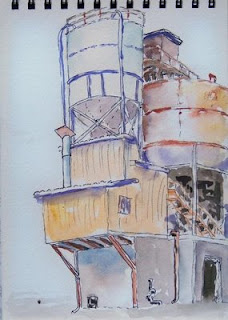Robert Small’s Raku - I am just back from a trip to the Mountlake Terrace Library. I stopped in to see a show advertised as Raku by Robert Small. I was disappointed and I will tell you why.
Raku is a process for firing ceramics, which introduces flammable material into final stages to induce a chemical reaction in special glazes producing an iridescent effect in the finished product. Raku can lead to stunning pieces that seem to change color as the light changes around them. I was prepared and expecting this sort of pottery.
Instead, I found twenty-five ceramic slabs, some flat and some bent in undulating waves. They vary in size, but are generally between one to two feet in length and about a foot in height. The slabs are decorated with scenes carved into the clay with crisp, illustrative lines. A descriptive banner proclaims that these are “Clay Art Scenes.”
The scenes presented come in three motifs or flavors: Mountain, Desert and Cityscape. The mountain scenes feature rolling hills, idealized evergreens and sometimes a little cabin. The same little cabin makes an appearance in four of the pieces. The desert scenes are recognizable by the many Saguaro Cacti, often silhouetted against a glowing sunset. The cityscapes all contain a Space Needle rising above the other structures.
Each cityscape was separately titled. This show contains: Twilight Skyline, Queen City Silhouette, Seattle Skyline, Seattle Copper Skyline and Emerald City Skyline. I could not help but wonder whether Small would simply run out of names for this image before he grew tired of reproducing it.
I did not find the show satisfying or significant. The ceramic works in this show are superficial and sentimental. They are in a word, “Kitsch”.
I search myself for the source of my negativity around this show. Small is a retired Doctor of Optometry, now spending a considerable part of his retirement creating these clay scenes in the hope of putting a smile on some unfamiliar face. How can I fault him for that? Am I just being grumpy?
My answer is that his work shows more promise than this show produces. He has achieved some brilliant glazing and interesting textures. Although, I would have preferred more of the typical Raku iridescence evidenced in the shimmering olive green over the coppery glaze in “Seattle Skyline.” I would have also preferred images that granted more authority to the viewer: increased subtlety and softer edges to the shapes. Small’s work moves in these directions with “Mountain Triptych”, “Lone Pine” and “Fingers of the Night.”
I was bothered with this show because I can see unrealized potential for significant works of art. But Small will need to re-imagine his gift store craft as credible gallery art.
Raku by Robert Small is located at the Mountlake Terrace Library located at 23300 - 58th Ave. West, Mountlake Terrace, Washington. They are open at 10:00 a.m., Monday through Saturday. This exhibition continues through the end of June 2009.



